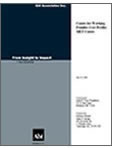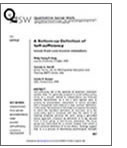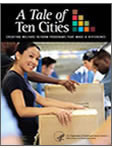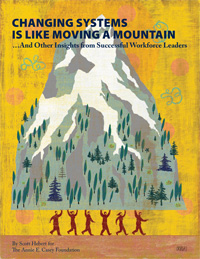
 MET Center Cost Analysis (152KB) Organizations that are considering adopting the Center for Working Families (CWF) model want to understand the costs they are likely to incur in implementing the approach. In order to provide this information to potential new sites, the Annie E. Casey Foundation asked Abt Associates to document the costs of three types of CWF interventions—a CWF based at a community college, a CWF based at a neighborhood-focused, community-based organization, and a CWF based at a one-stop comprehensive program center serving a broad geographic area. Each of the sites selected to represent these intervention types is also included in the CWF evaluation. This report focuses on a one-stop comprehensive program model and documenting the costs that the Metropolitan Education and Training Center in St. Louis (MET Center) incurred during the first two years of CWF operation (July 2006 through June 2008).
MET Center Cost Analysis (152KB) Organizations that are considering adopting the Center for Working Families (CWF) model want to understand the costs they are likely to incur in implementing the approach. In order to provide this information to potential new sites, the Annie E. Casey Foundation asked Abt Associates to document the costs of three types of CWF interventions—a CWF based at a community college, a CWF based at a neighborhood-focused, community-based organization, and a CWF based at a one-stop comprehensive program center serving a broad geographic area. Each of the sites selected to represent these intervention types is also included in the CWF evaluation. This report focuses on a one-stop comprehensive program model and documenting the costs that the Metropolitan Education and Training Center in St. Louis (MET Center) incurred during the first two years of CWF operation (July 2006 through June 2008).
 MET Publication Dr Hong QSW 2009 (153KB) OA Bottom-up Definition of Self-sufficiency Voices from Low-income Jobseekers, Self-sufficiency (SS) is the epitome of America’s ‘reluctant’ welfare state. It is generally accepted in social welfare policy circles as a concept related to independence and financial stability. Nevertheless, SS is not a term agreed upon in practice by policymakers, researchers, or service providers and is frequently used without a clear common definition. In this sense, the purpose of this study is to explore the extent to which the top-down definition of ‘economic’ SS as the social policy goal is consistent with how the clients of job training programs perceive the term. Using a grounded theory approach, a bottom-up definition of SS was derived from a focus group of low-income jobseekers. The focus group was transcribed for a content analysis from which a client-centered definition of SS was drawn. Findings suggest that SS is a process of developing psychological strengt
MET Publication Dr Hong QSW 2009 (153KB) OA Bottom-up Definition of Self-sufficiency Voices from Low-income Jobseekers, Self-sufficiency (SS) is the epitome of America’s ‘reluctant’ welfare state. It is generally accepted in social welfare policy circles as a concept related to independence and financial stability. Nevertheless, SS is not a term agreed upon in practice by policymakers, researchers, or service providers and is frequently used without a clear common definition. In this sense, the purpose of this study is to explore the extent to which the top-down definition of ‘economic’ SS as the social policy goal is consistent with how the clients of job training programs perceive the term. Using a grounded theory approach, a bottom-up definition of SS was derived from a focus group of low-income jobseekers. The focus group was transcribed for a content analysis from which a client-centered definition of SS was drawn. Findings suggest that SS is a process of developing psychological strengt
 Tale of Ten Cities (1.1MB) The purpose of this publication is to showcase the outstanding efforts of ten cities that implemented groundbreaking programs to meet the needs of families receiving Temporary Assistance for Needy Families (TANF). We want to demonstrate how these innovative efforts can be applied in other urban areas throughout the Nation. The goal is to make TANF program staff in cities across the United States aware that tools are available to help with the implementation of their own groundbreaking programs that will enable their city to write their own success story during the next decade of welfare reform. With the passage of the Personal Responsibility and Work Opportunity Reconciliation Act (PRWORA) in 1996, the role of the States and the Federal government shifted significantly as OFA began providing States with TANF block grants through the TANF program.
Tale of Ten Cities (1.1MB) The purpose of this publication is to showcase the outstanding efforts of ten cities that implemented groundbreaking programs to meet the needs of families receiving Temporary Assistance for Needy Families (TANF). We want to demonstrate how these innovative efforts can be applied in other urban areas throughout the Nation. The goal is to make TANF program staff in cities across the United States aware that tools are available to help with the implementation of their own groundbreaking programs that will enable their city to write their own success story during the next decade of welfare reform. With the passage of the Personal Responsibility and Work Opportunity Reconciliation Act (PRWORA) in 1996, the role of the States and the Federal government shifted significantly as OFA began providing States with TANF block grants through the TANF program.
 Changing Systems is Like Moving a MountainThe philanthropic community can benefit from more consistent analysis and in-depth discussion of the traits, talents and tactics that make for good leadership – in particular the area of “system change.” In the workforce development field, the “system” is the combination of rules, behaviors, and investments by public and private institution that affect how regional labor markets operate. System change is important because, while innovative employment projects are important, the needs of thousands of workers and businesses cannot be addressed without changing the way the system operates. This report responds to the need for more information on the important work of leaders in changing systems by offering insights and observations from more than a dozen leaders who have worked on system change in the workforce development field. Spurred by new and rapidly evolving industries, employers are taking new approaches to how employees work, with an increased reliance on technology. However, there is a gap between the skillsets needed in the workplace and the preparedness of post- Baby Boomers coming out of school. The workforce development system needs to be better equipped to deal with this challenge and help bridge this gap.
Changing Systems is Like Moving a MountainThe philanthropic community can benefit from more consistent analysis and in-depth discussion of the traits, talents and tactics that make for good leadership – in particular the area of “system change.” In the workforce development field, the “system” is the combination of rules, behaviors, and investments by public and private institution that affect how regional labor markets operate. System change is important because, while innovative employment projects are important, the needs of thousands of workers and businesses cannot be addressed without changing the way the system operates. This report responds to the need for more information on the important work of leaders in changing systems by offering insights and observations from more than a dozen leaders who have worked on system change in the workforce development field. Spurred by new and rapidly evolving industries, employers are taking new approaches to how employees work, with an increased reliance on technology. However, there is a gap between the skillsets needed in the workplace and the preparedness of post- Baby Boomers coming out of school. The workforce development system needs to be better equipped to deal with this challenge and help bridge this gap.
All publications are in PDF format.
If PDF reader is not installed on your pc a free one can be downloaded using the following link
Adobe Acrobat Reader


